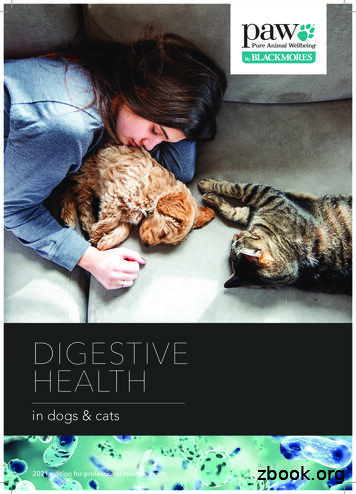DIGESTIVE SYSTEM IN PRIMATES - IPB University
DIGESTIVE SYSTEM IN PRIMATESAni Mardiastuti
Main Components of FoodsFoodWaterDry MatterInorganic- Macro elements- Trace elementsOrganic- Lipids- Proteins- Carbohydrate- Vitamins- Others
Water Sources for Primates Free watersLakes, streams, dew on vegetation Water from food consumed Metabolic waterProduced during the breakdown processed ofproteins, carbohydrate and fats
Folivore The long-chain carbohydrates found in leavesand structural plant parts require bacterialdecomposition (fermentation) for digestionand assimilation Adaptations for fermentation:– chambers in the fore-gut (stomach)– chambers or mid-gut (cecum and colon)
Digestive SystemFaunifloryFolivorySimple digestivesystemComplex digestivesystemFoods are easyto digest(60-90%)Foods aredifficult todigestSimple s
Primate Dentition
Insectivores High, pointy cusps on the teeth, includingthe molars, for breaking into the insect’stough exoskeletons Short, simple digestive tract
Frugivores Wide incisors for scraping out the meat offruits from their rinds Sturdy canines for puncturing and tearing fruitrinds without breaking off Low, rounded molar cusps for pulverizing fruit The gastrointestinal tracts: little structuralspecialization
Folivores Physical adaptations that promote - throughsymbiotic microbial fermentation and mechanicalaction - the degradation of the structural andchemical defenses of plants Enlargements of the stomach or the hind gut toaccommodate microbial fermentation Gastrointestinal tract modification is related to theproportions of plant parts (leaves, seeds, and fruits)consumed
Asian ColobinesNasalis, Presbytis, Trachypithecus Less-digestible plant materials in the naturaldiet Small intestines: 8x body length Large intestines: 2x body length Cecum: ¼ body length, secondary site ofmicrobial fermentation
Gastrointestinal Tracts
BushbabyTarsierNight Monkey
BaboonChimpanzeeOrangutan
Wooly MonkeyColobus MonkeyMacaque
ColobinesCercopithecines
Food Digestion Folivores:the foods require fermentation in a largestomach or the large intestine/colon Faunivores:gut structure simple globular stomach,small intestine, short conical cecum, andsimple smooth-walled colon
How much food does a primate need?Depends on: Basal metabolic rate (BMR) Activity Growing stage Reproduction stagePregnancy: up to a 25% increase in caloricintake; lactation: up to a 50% increase in caloricintake
Basal Metabolic Rate (BMR) BMR: the minimum calorific requirementneeded to sustain life in a resting individual Generally accepted to be 290 kJ/kg b d y Depends on– body size– home range– vulnerability to predation– position in their group’s dominance hierarchy
BMR Larger animals require more energy to maintain theirbodies than smaller ones higher BMR Larger bodies are more efficient because their largerbodies conserve heat better Although a larger animal needs more calories in total,it needs fewer calories per pound of body weightthan a smaller animal Smaller animal has to eat more relative to its bodyweight concentrate on foods with a high caloricpayoff per pound or per volume of food
Lack of Food May Lead to: Changes in dietChanges in feeding behaviorLowered reproductive outputMigrate to other siteHeavy mortality
Digestive System Fauniflory Folivory Simple digestive system Complex digestive system Foods are easy to digest (60-90%) . Larger animals require more energy to maintain their . Microsoft PowerPoint
Label The Digestive System. 5. 6 . Kids Health Digestive System. 8 peristalsis major filter of body produces insulin stores bile filters absorbs food mechanical and chemical produces extra white blood cells absorbs water Name the organs in the Digestive System. 9
ruminant stomach occupies almost 75 percent of the abdominal cavity, filling nearly all of the left side and extending significantly into the right side. The relative size of the four compartments is as follows: the rumen and reticulum comprise 84 percent of the volume of the total stomach, the omasum 12 percent, and the abomasum 4 percent.File Size: 318KBPage Count: 8Explore further4 Grains You Can Feed Your Livestock - Hobby Farmswww.hobbyfarms.comUnderstanding the Ruminant Animal Digestive System .extension.msstate.eduHow the Digestive System Works in a Cow & Other Ruminants .proearthanimalhealth.comRuminant Digestive System - Basic Concept, Examples .www.vedantu.comThe ruminant digestive system - Extension at the .extension.umn.eduRecommended to you based on what's popular Feedback
LAB _. DIGESTIVE SYSTEM 1. Separate the papers with the illustrations of the human digestive system organs. 2. Color the parts of the human digestive system in the following way: a. BLUE — Mouth, Esophagus, Stomach, Small Intestines b. PINK or RED — Digestive Glands: Salivary Glands, Pancr
Workbook 13 The digestive system 13.3 Digestive system The task of the digestive system is the physical and chemical breakdown of food. Following ingestion, food and fluids are processed by the digestive organs, so that nutrients can be absorbed from the intestines and circulated around the body.
Digestive disorders behavioural in dogs and cats Digestive disorders are common in companion animals and cause stress to both pet and owner.3 Any condition that reduces the digestion or absorption of food, or alters its transit through the digestive tract can be considered a digestive disorder.4 In practice, veterinarians are most
5 TEACHER’S GUIDE PIE by I OINI I WIC TEACHING Primates is a graphic novel about primates, primatology, and what its like to be a scientist heading out into uncharted territory, both literally and figuratively. So the opportunities to teach from it range from talking about
Non-human primates Social cognition Theory of mind Knowledge representation Violation of expectation ABSTRACT Although non-human primates (NHPs) generally appear to predict how knowledgeable agents use knowledge to guide their behavior, the cognitive mechanisms that enable this remain poorly understood. We assessed the
on top of it, including the ASP.NET MVC, Entity Framework, and Enterprise Library. Since it has been around for a long time, most legacy and existing .NET applications are developed for the .NET Framework, and it also has the richest set of libraries, assemblies, and an ecosystem of packages. One of the key challenges for .NET Framework applications is that backward- compatibility can be .






















